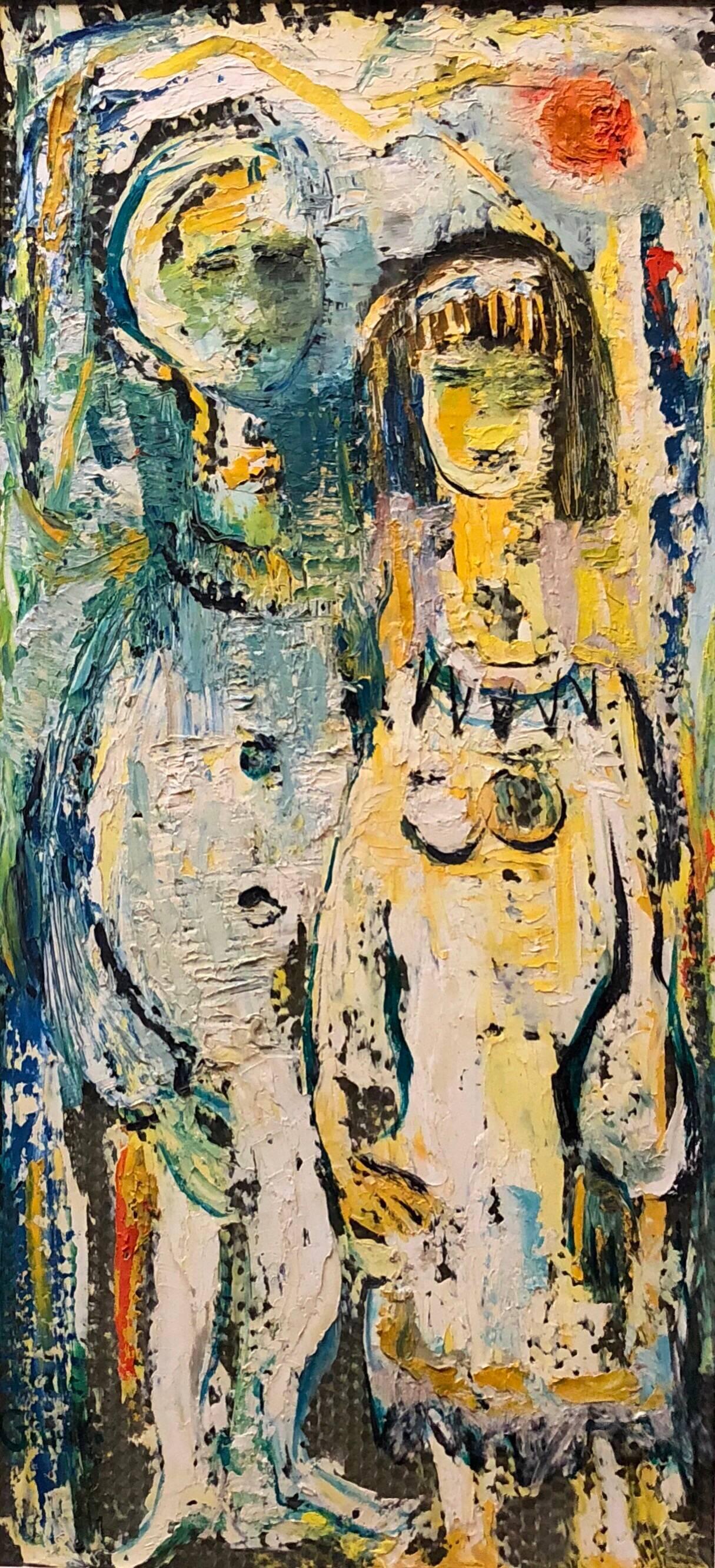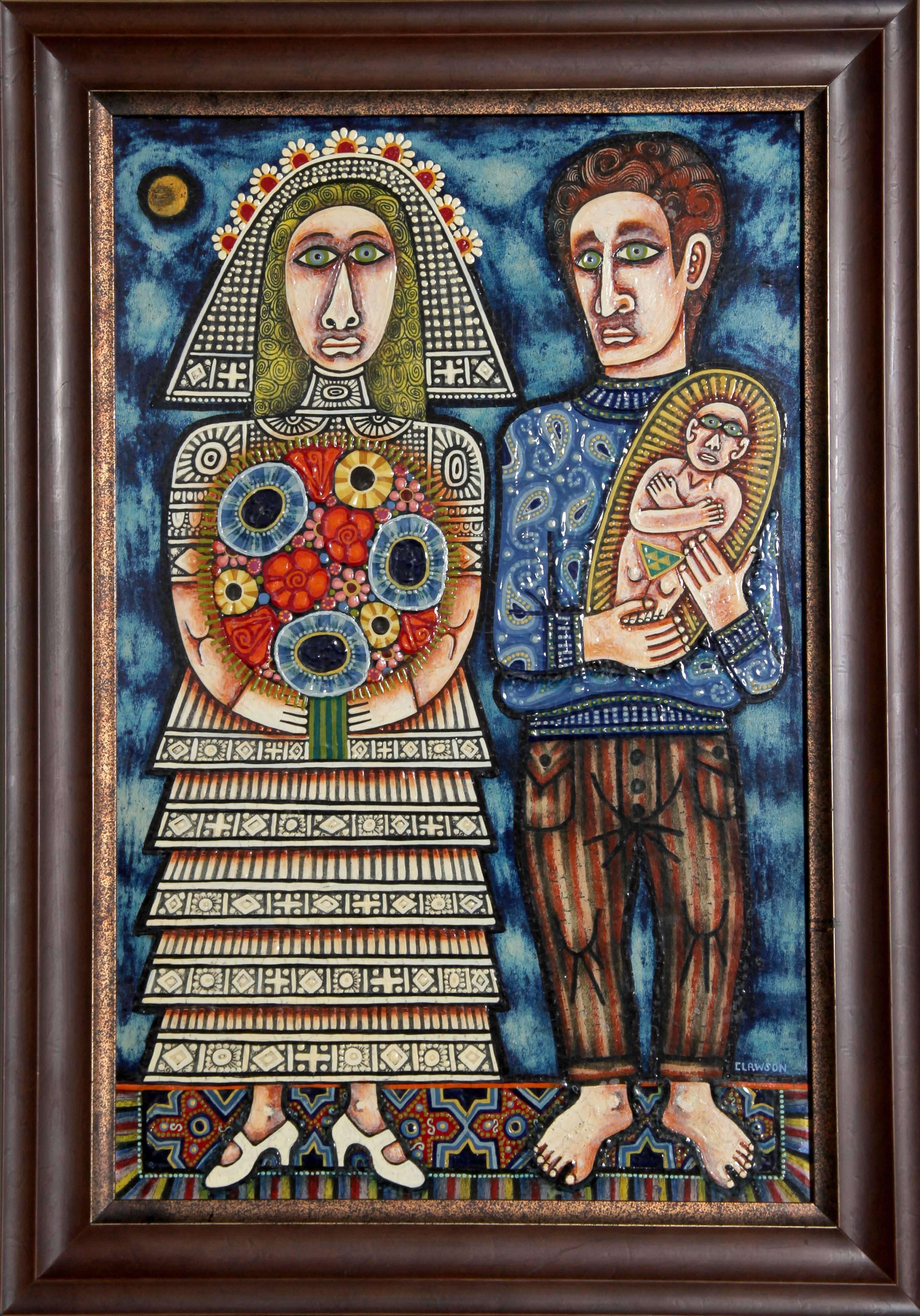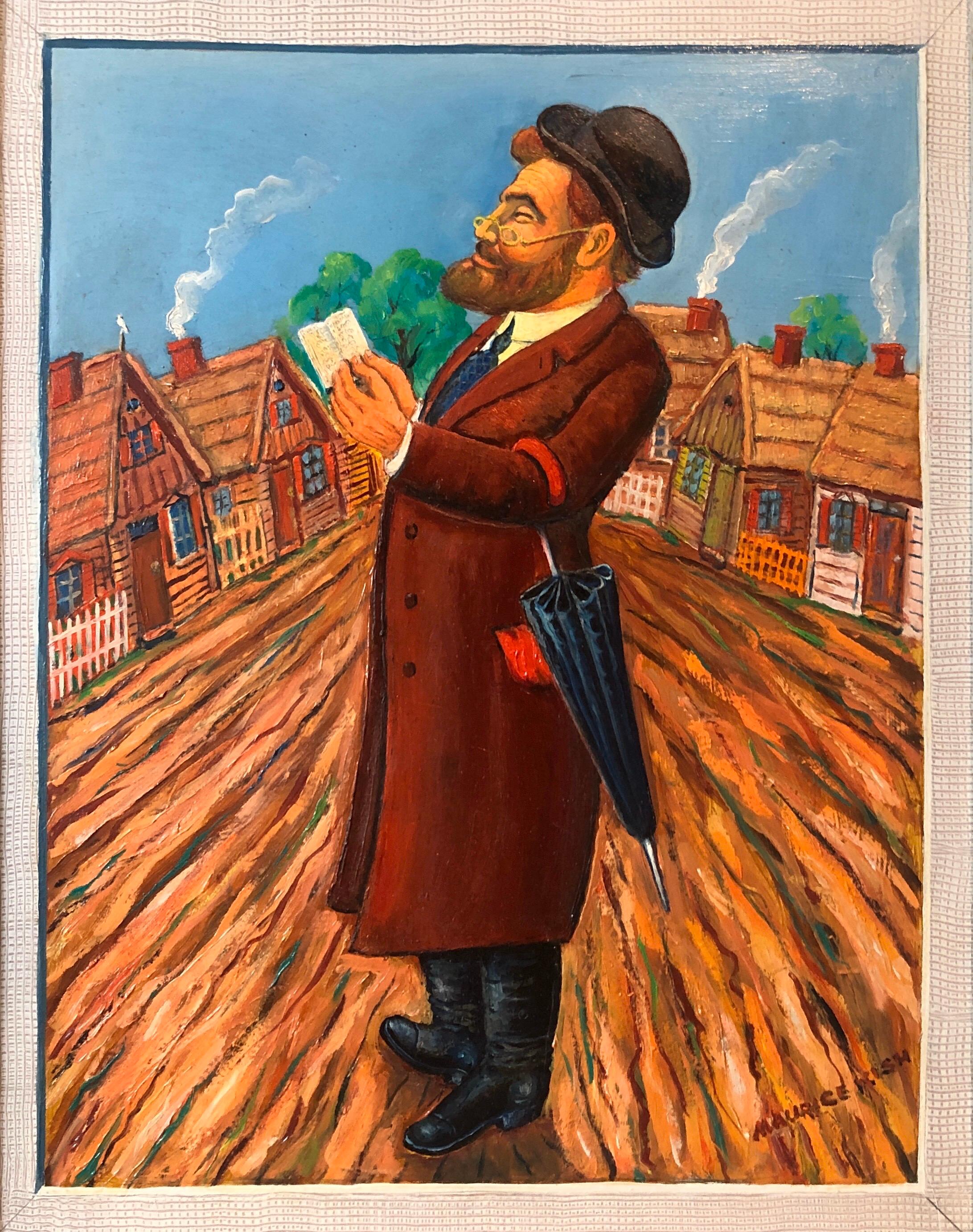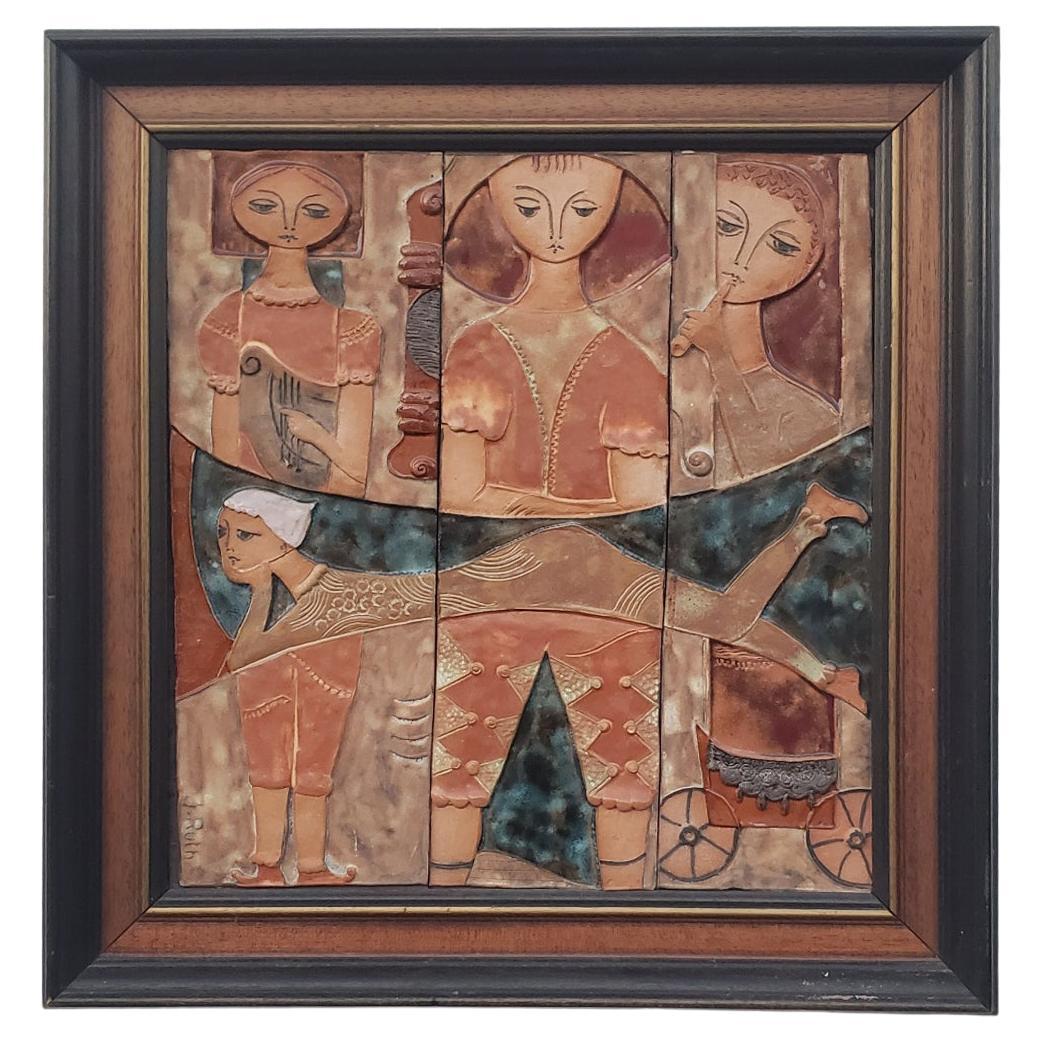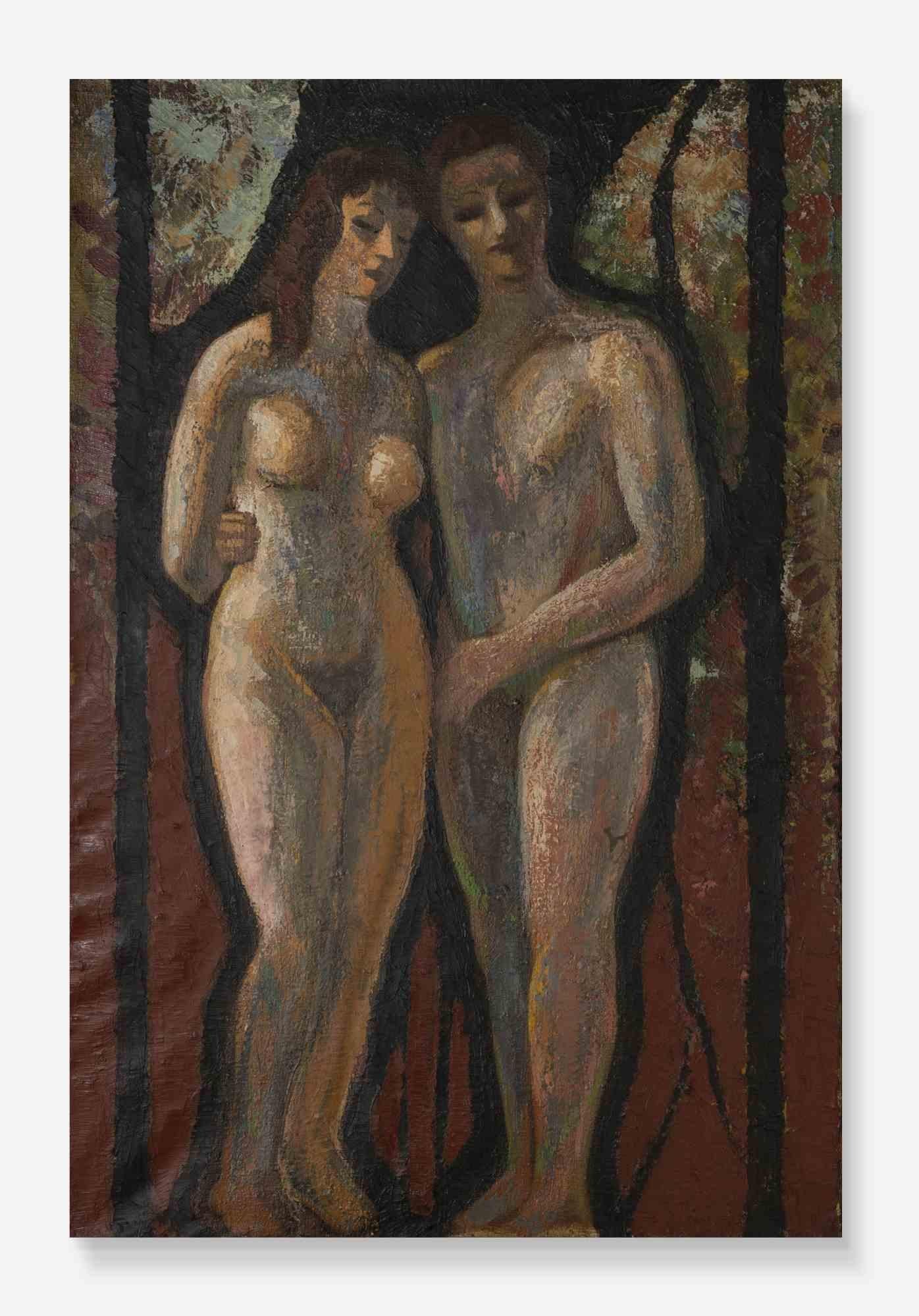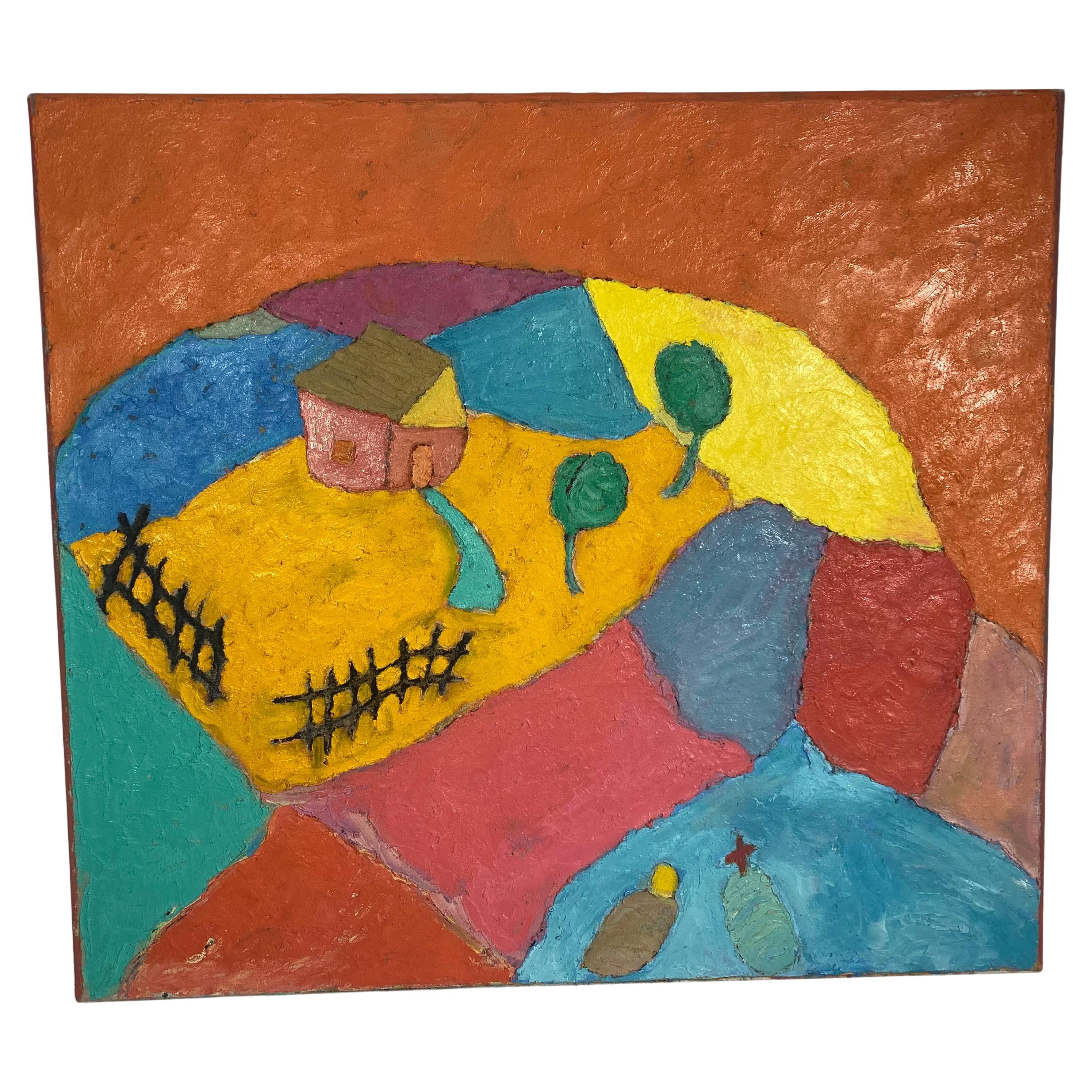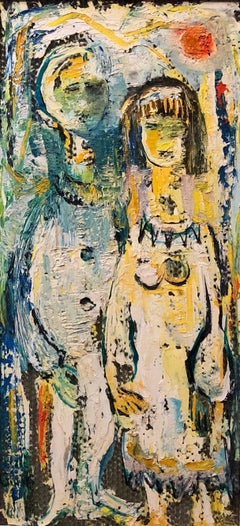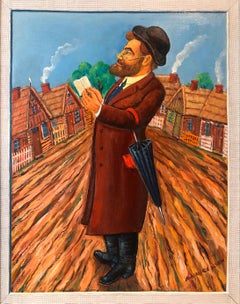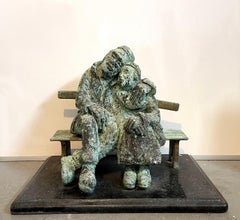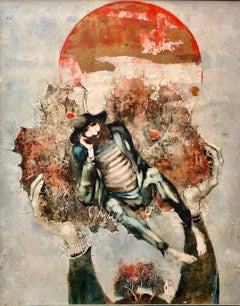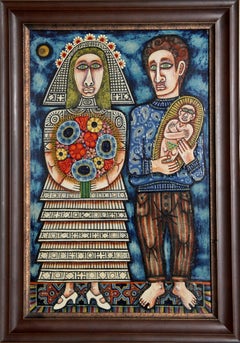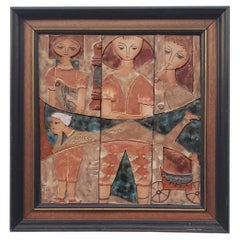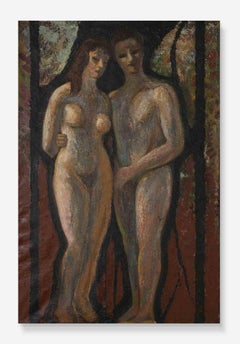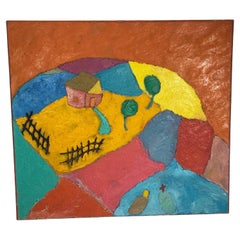Items Similar to Judaica Painting w Sculpture Terra Cotta Jewish Couple Israeli Artist Kanovich
Want more images or videos?
Request additional images or videos from the seller
1 of 17
Mark KanovichJudaica Painting w Sculpture Terra Cotta Jewish Couple Israeli Artist Kanovich
$1,800
£1,366.53
€1,563.02
CA$2,514.86
A$2,797.07
CHF 1,460.55
MX$34,037.42
NOK 18,653.39
SEK 17,493.59
DKK 11,665.40
Shipping
Retrieving quote...The 1stDibs Promise:
Authenticity Guarantee,
Money-Back Guarantee,
24-Hour Cancellation
About the Item
Original Painting: Terracotta Relief With Acrylic Painting on Wood Panel
Hand signed
These works are paintings with a 3D carved sculpture dimension to them, fusing sculpture with painting
Mixed media on board depicting a romantic couple, a woman seated on a man's lap.
Mark Kanovich (Russian-Georgian, Israeli, 1970-) was born in Tbilisi, Georgia, on May 1, 1970, and now lives and works in Tel-Aviv. The world of Kanovich is one in which man is constantly seeking love, beauty, warmth, humor and generosity. His fantastic realism focuses on dimension, movement and form, staging his figures through unique and sharp perspectives and unusual and innovative techniques, which fuse sculpture and painting. While his work is clearly inspired by the works of Marc Chagall, Kanovich’s images are equally romantic but often invoke a poignant sense of longing. They have a primitive, naive, folk art quality to them.
Kanovich’s great-grandfather was a wealthy carpet salesman who was very orthodox in his beliefs. He met his Polish wife in Warsaw, Poland and took her back to Tbilisi. Mark developed his artistic qualities from a very early age. He studied architecture at the University and at 18 he was forced to join the army (Soviet Russian, USSR) according to a new law which made military service mandatory for students. He was recruited to design information centers. One day he designed a poster of Lenin that the commander in chief at the time disapproved. He thought the image was ridiculing the great leader. Kanovich was placed in military jail for a few days. This episode had such an effect on him that he made an oath never to draw anything political for the rest of his life.
At the end of his military service he spent another year at the University, and then decided to make “Aliya” – to immigrate to Israel. He moved to Israel in 1992 and studied art at the Avni institute in Tel-Aviv. His tiny studio apartment was dark and cold; he had to work three different jobs to support himself, painting his own art at night. Adjusting to a new life in a small, unfamiliar country was difficult and Mark’s extraordinary success was due to his hard work and dedication. His current studio resides in a former Kibbutz and British Military office. There he works each day with other artist and friends, including Yaacov Agam, David Najar, Yuval Wolfson and until his passing in 2012, Itzchak Tarkay with whom Mark was very close, and who mentored him and supported his career.
His work has been shown at various museums and galleries, including the History Museum in Tbilisi (1991); “Kikar” gallery in Jaffa (1994, 1997); The Art Center in Rishon Le-Zion (1995); “Danon” Gallery in Tel-Aviv (2000); “Jerusalem Theater” in Jerusalem (2002); Issachar Ber Ryback House Museum in Bat-Jam (2003); and the Bible Museum in Tel-Aviv (2005).
- Creator:Mark Kanovich (1970, Georgian)
- Dimensions:Height: 27.5 in (69.85 cm)Width: 19.5 in (49.53 cm)
- Medium:
- Movement & Style:
- Period:
- Condition:good. minor surface loss at bottom corner. can be covered by mat when framed.
- Gallery Location:Surfside, FL
- Reference Number:1stDibs: LU38216654872
About the Seller
4.9
Platinum Seller
Premium sellers with a 4.7+ rating and 24-hour response times
Established in 1995
1stDibs seller since 2014
1,784 sales on 1stDibs
Typical response time: <1 hour
- ShippingRetrieving quote...Shipping from: Surfside, FL
- Return Policy
Authenticity Guarantee
In the unlikely event there’s an issue with an item’s authenticity, contact us within 1 year for a full refund. DetailsMoney-Back Guarantee
If your item is not as described, is damaged in transit, or does not arrive, contact us within 7 days for a full refund. Details24-Hour Cancellation
You have a 24-hour grace period in which to reconsider your purchase, with no questions asked.Vetted Professional Sellers
Our world-class sellers must adhere to strict standards for service and quality, maintaining the integrity of our listings.Price-Match Guarantee
If you find that a seller listed the same item for a lower price elsewhere, we’ll match it.Trusted Global Delivery
Our best-in-class carrier network provides specialized shipping options worldwide, including custom delivery.More From This Seller
View AllUntitled Couple Mid Century Jewish Expressionist OIl Painting
By Belle Golinko
Located in Surfside, FL
Abstracted painting of a man and a woman, the paint has been applied to textured plastic.
An abstracted painting of a couple applying paint to the textured plastic surface. Genre Expressionist Fauvist Subject People Medium Acrylic Plastic Surface Board Country United States Dimensions 24" x 11 1/2"
She exhibited her painting at the famous Jewish art show held at the Dallas Museum
Contemporary Fine Arts Exhibition of the American Jewish Tercentenary in 1955 alogside artists Aarons, George, Benn, Ben, Berkman, Aaron, Bloom, Hyman
Bohrod, Aaron Gottlieb, Adolph, Gropper, William, Gross, Chaim Gurr, Lena amongst others.
Born in 1899, Belle Golinko is a listed Jewish mid...
Category
1950s Expressionist Figurative Paintings
Materials
Plastic, Oil
Whimsical Judaica Shtetl Shadchan Matchmaker Oil Painting WPA Jewish Folk Artist
By Maurice Kish
Located in Surfside, FL
Genre: Modern
Subject: Fiddler on the roof, Shtetl matchmaker
Medium: Oil
Surface: Board, size includes artist decorated frame
Country: United States
The imagery of Maurice Kish (18...
Category
Mid-20th Century Folk Art Figurative Paintings
Materials
Oil, Board
Heavy Bronze Sculpture Austrian Israeli judaica Jewish Couple Bench Nicky Imber
By Nicky Imber
Located in Surfside, FL
Large and heavy with magnificent patina. This is the large version of this piece. we cannot find any markings on it and it might be unique.
Nicky Imber (Vienna, Austria, 1920 -1996) was a multidisciplinary Jewish artist best known for his sculptures on Jewish themes. Grand nephew of Naftali Herz Imber, author of the Israeli national anthem 'Hatikva'.
After escaping the Nazi concentration camp in Dachau, he pledged to dedicate his art to perpetuating the memory of the Holocaust. Among his more famous works are "The Hope" and "The Love of Torah". His work can be seen around the world, in Northern Israel, the United States, and the Venezuelan Museum of Natural History in Caracas.
Nicky Imber was born in Vienna, Austria. During his studies at the Academy of Arts in Vienna, he drew anti-Nazi caricatures for Jewish student publications. After several thwarted attempts by the family to leave Vienna, in 1938, in the wake of the 'Anschluss', Imber was deported to Dachau. Witnessing the murders of family and friends, he plotted his escape. Using skills he had learned in art school, he made a face mask out of bread and sand, stole a Nazi soldier's uniform and walked out the front gate unnoticed. In 1940, he boarded a ship headed to Haifa. The ship's passengers were refused entry by the British mandatory authorities and imprisoned in a detention camp in Mauritius.
In 1943, Imber worked out a deal with the authorities for his release by joining the British Army, serving as a war artist and a dental assistant in East Africa. After the war, he opened an art school in Nairobi, Kenya, and worked as a photographer and a safari guide.
In 1949 to 1954, he lived in Venezuela, where he was contracted to do an East African Diorama series. The National Museum added an entire wing to display it.
During this period he got married and had a daughter Raquel, who accompanied and assisted him.
In 1959, Imber was commissioned to create sculptures and dioramas for the Haifa Prehistory Museum at Gan Ha-em in Haifa, Israel. In 1960 he returned to Venezuela to restaured the Phelps series of Dioramas for the Museum in Caracas.
Between 1961 and 1971 he travelled extensively around Europe and after establishing an international name for himself, returned to the United States. In New York he became famous for his realistic oil paintings of portraits of Aga Khan, Tyrone Power, Ava Gardner, David Ben-Gurion, Golda Meir, Sir Richard Burton...
Category
Mid-20th Century Post-Impressionist Figurative Sculptures
Materials
Marble, Bronze
Mid Century Hungarian Gilt Oil Painting on Board Modern Judaica
Located in Surfside, FL
From a collection by a long time Miami Beach art dealer on the old Lincoln Rd. This is a piece he brought back from hungary. from a collection of good Hungarian artists and Illustrat...
Category
20th Century Modern Figurative Paintings
Materials
Oil, Board
Simka Simkhovitch WPA Artist Oil Painting Family Mother, Kids American Modernist
By Simka Simkhovitch
Located in Surfside, FL
Simka Simkhovitch (Russian/American 1893 - 1949)
This came with a small grouping from the artist's family, some were hand signed some were not.
These were studies for larger paintings.
Simka Simkhovitch (Симха Файбусович Симхович) (aka Simka Faibusovich Simkhovich) (Novozybkov, Russia May 21, 1885 O.S./June 2, 1885 N.S.—Greenwich, Connecticut February 25, 1949) was a Ukrainian-Russian Jewish artist and immigrant to the United States. He painted theater scenery in his early career and then had several showings in galleries in New York City. Winning Works Progress Administration (WPA) commissions in the 1930s, he completed murals for the post offices in Jackson, Mississippi and Beaufort, North Carolina. His works are in the permanent collections of the Dallas Museum of Art, the National Museum of American Art and the Whitney Museum of American Art. Born outside Kyiv (Petrograd Ukraine) into a Jewish family who owned a small department store. During a severe case of measles when he was seven, Simcha Simchovitch sketched the views outside his window and decided to become an artist, over his father's objections. Beginning in 1905, he studied at the Grekov Odessa Art School and upon completion of his studies in 1911 received a recommendation to be admitted to the Imperial Academy of Arts. Though he enrolled to begin classes in architecture, painting, and sculpture at the Imperial Academy, he was dropped from the school roster in December because of the quota on the number of Jewish students and drafted into the army. Simchovitch served as a private in the 175th Infantry Regiment Baturyn [ru] until his demobilization in 1912. Re-enrolling in the Imperial Academy, he audited classes.
Simka Simkhovitch exhibited paintings and sculptures in 1918 as part of an exhibition of Jewish artists and in 1919 placed 1st in the competition "The Great Russian Revolution" with a painting called "Russian Revolution" which was hung in the State Museum of Revolution. In 1922, Simkha Simkhovitch exhibited at the International Book Fair in Florence (Italian: Fiera Internazionale del Libro di Firenze). In 1924, Simkhovitch came to the United States to make illustrations for Soviet textbooks and decided to immigrate instead. Initially he supported himself by doing commercial art and a few portrait commissions. In 1927, he was hired to paint a screen for a scene in the play "The Command to Love" by Fritz Gottwald and Rudolph Lothar which was playing at the Longacre Theatre on Broadway. Art dealers began clamoring for the screen and Simkhovitch began a career as a screen painter for the theater. Catching the attention of the screenwriter, Ernest Pascal, he worked as an illustrator for Pascal, who then introduced him to gallery owner, Marie Sterner. Simkhovitch's works appeared at the Marie Sterner Gallery beginning with a 1927 exhibit and were repeated the following year. Simkhovitch had an exhibit in 1929 at Sterner's on circus paintings. In 1931, he held a showing of works at the Helen Hackett Gallery, in New York City and later that same year he was one of the featured artists of a special exhibit in San Francisco at the California Palace of the Legion of Honor in Lincoln Park. The exhibit was coordinated by Marie Sterner and included four watercolors, including one titled "Nudes". He is of the generation of Russian Soviet artists such as Isaac Pailes, Serge Charchoune, Marc Chagall, Chana Orloff, Isaac Ilyich Levitan, and Ossip Zadkine.
In 1936, Simkhovitch was selected to complete the mural for the WPA Post office project in Jackson, Mississippi. The mural was hung in the post office and courthouse in 1938 depicted a plantation theme. Painted on the wall behind the judge’s bench, “Pursuits of Life in Mississippi”, a depiction of black workers engaged in manual labor amid scenes of white professionals and socialites, was eventually covered over in later years during renovations due to its stereotypical African American imagery. The following year, his painting "Holiday" won praise at an exhibition in Lincoln, Nebraska. In 1940, Simkhovitch's second WPA post office project was completed when four murals, "The Cape Lookout Lighthouse and the Orville W. Mail Boat", "The Wreck of the Crissie Wright", "Sand Ponies" and "Canada Geese" were installed in Beaufort, North Carolina. The works were commissioned in 1938 and did not generate the controversy that the Jackson mural had. The main mural is "The Wreck of the Crissie Wright" and depicts a shipwreck which had occurred in Beaufort in 1866. "The Cape Lookout Lighthouse and the Orville W. Mail Boat" depicted the lighthouse built in 1859 and the mail boat that was running mail during the time which Simkhovitch was there. The boat ran mail for the area until 1957. "Sand Ponies" shows the wild horses common to the North Carolina barrier islands and "Canada Geese" showed the importance of hunting and fishing in the area. All four murals were restored in the 1990s by Elisabeth Speight, daughter of two other WPA muralists, Francis Speight...
Category
1930s American Modern Figurative Paintings
Materials
Oil, Board
Judaica Polish Israeli Folk Art Biblical Modernist Oil Painting
By Pinchas Shaar
Located in Surfside, FL
This painting is iconic of Pichas Shaar's aesthetic, and stylistic influences. A ceramic mosaicist and sculptor as well as a painter, Shaars strong decorative sense was evident in his colorful canvas, with their frequent rectilinear geometry, depicting stylized figures, often mythological or biblical subjects.
Pinchas Shaar (born Szwarc, later Shaar) was born in Lodz, Poland in 1923. already at a young age he drew small graffiti and characters of fairy tales. at sixteeen he met the Polish painter Wladyslaw Strzeminski, a disciple of the Russian painter Kazimir Malevich, who encouraged Pinchas’ artistic education. Strzeminski encouraged Pinchas' artistic education and introduced him to the works of such painters as Picasso, Leger, Matisse, and Mondrian. Pinchas had his first exhibition in 1938 and also completed photomontages for a poetry book by Moshe Broderson that was published in 1939. Then, in September 1939, Nazi Germany invaded Poland. On February 1940 the Jews of Lodz had to move to a ghetto and perform forced labor. The artist experienced the horrors of war and the Nazi holocaust concentration camps. Pinchas worked in a prefabricated furniture factory. However, after his artistic abilities were discovered, he became a draftsman. He also designed decorations for the ghetto's theater. In 1944 the Germans liquidated the Lodz ghetto...
Category
1960s Folk Art Figurative Paintings
Materials
Canvas, Oil
You May Also Like
Family, Folk Art Oil Painting on Board by Rex Clawson
By Rex Clawson
Located in Long Island City, NY
Artist: Rex Clawson, American (1929 - 2007)
Title: Family
Year: circa 1979
Medium: Oil on Board, signed l.r.
Size: 22 in. x 14 in. (55.88 cm x 35.56 cm)
Frame Size: 26 x 18 inches
Category
1970s Modern Figurative Prints
Materials
Oil, Board
Ruth Faktor Faktorowicz Modernist Israeli Figurative Ceramic Tile Wall Art
Located in Middlesex, NJ
Ruth Faktor Faktorowicz Modernist Israeli Figurative Ceramic Tile Wall Art
Category
20th Century Israeli Wall-mounted Sculptures
Materials
Ceramic, Porcelain
The Couple - Oil Paint attr. Edgar Stoebel - Mid-20th Century
By Edgar Stoëbel
Located in Roma, IT
The couple is an artwork attribuited to Edgar Stoebel (1909-2001).
81 x 54 cm; no frame.
Oil painting on canvas.
Good conditions!
Category
Mid-20th Century Modern Nude Paintings
Materials
Canvas, Oil
Peter Arvidson Post Modern Modernist American Painter 'the Lovers" 1993, Oil
By Peter Anderson
Located in Buffalo, NY
An original oil on canvas painting by listed Contemporary artist Peter Arvidson.
The thick imposto and color choices create a whimsical but striking ...
Category
1990s American Folk Art Paintings
Materials
Canvas, Paint
Ruth Faktor Faktorowicz Modernist Israeli Figurative Ceramic Tile Wall Art
Located in Middlesex, NJ
Ruth Faktor Faktorowicz Modernist Israeli Figurative Ceramic Tile Wall Art
Category
20th Century Israeli Wall-mounted Sculptures
Materials
Ceramic, Porcelain
Victorian Couple with Angel - Figurative Abstract
By David Rosen (b.1912)
Located in Soquel, CA
Moody figurative abstract expressionist painting of a Victorian couple with an angel by artist David Rosen (American, 1912-2004), c. 1970. Signed "Rosen" lower right. Unframed. Image size: 30.25"H x 26.38"W.
Born in 1912, Rosen grew up in Toronto, Canada before pursuing arts in the United States. Upon arriving, Rosen settled in New York City and attended the Cooper Union Art school in 1930. While participating in the Federal Arts Project, he worked for the program's mural department until 1941. He also worked with an artist collective, Siqueiros Art Workshop. There, Rosen met fellow FAP artist Jackson Pollack, and together, with artist Phillip Guston, they experimented with new painting techniques and mediums. Art movements are often reactions to the popular styles that precede them, and Abstract Expressionism applied a new and exciting method to Modern Art. Gradually, artists began to break away from an overly-studied, academic approach to painting and liberated their technique. During these workshops, Rosen was introduced to Pollack's groundbreaking "drip painting" before it changed the art world.
As America became involved in World War II, the Federal Arts Project wound down, officially ending in 1942. Around this time, Rosen enlisted as a Merchant Seaman with the U.S Merchant Marines. During this time, he traveled to North Africa and Italy before concluding his service and moving to California where, in 1945, he devoted his full attention to building an art career. Within a couple of years, he landed a major exhibition at the Los Angeles County Museum of Art in 1947, and his first one-man show, which opened to rave reviews, was held at Hollywood's Contemporary Art Gallery. The exhibition’s success led to mural commissions from Palm Springs' Hotel del Tahquitz, and he scored more solo shows at West Hollywood's Chabot Gallery.
The early 1950s brought a surge of recognition for Rosen's career, and while his work was certainly still influenced by Abstract Expression, his painting style included elements of Surrealism, Figurative Art, and Cubism. Like his colleague Jackson Pollack, Rosen produced work inspired by drip painting; however, rather than splattering, his drips were the natural flow marks from painting freely without regard for "mistakes." Throughout Rosen's long career, he would acquire techniques from vastly different art styles which made for a varied, eclectic catalog of work.
Rosen continued to build his California art career and settled at a Laguna Beach art colony in 1958. There, he entered his work in the Laguna Beach Festival of Arts and was the first painter to contribute Abstract Art to the event. Rosen would participate in the festival for the next fifteen years. A year after his move, in 1959, Rosen opened his first studio gallery and began a 12-year collaboration with the Laguna Playhouse. For the next two decades, Rosen participated in 17 art exhibitions and 20 solo shows, and received considerable critical praise.
Rosen's themes were as varied as his evolving painting style, and one of his themes focused on classic characters like Shakespeare's Hamlet. Rosen's close-up portraits of historical and literary figures, illustrated by the piece To Be or Not to Be: Soliloquy From Hamlet, capture the essence of the characters while remaining loose with the painting and even adding a slight cartoon feel. His ongoing Hamlet series, as a complete collection, makes an impact with the diversity of technique. Unlike the loose style of some of his works, the painting Madaam... that he is mad is true is influenced by the structure of Cubism, the flat dimensions of Byzantine Art, and his utilization of mixed media.
After Rosen's death in 2004, the Laguna Beach Festival of Arts sponsored an exhibition of his Hamlet paintings at the Wells Fargo Building gallery. Throughout Rosen's career, he amassed a great deal of critical, industry, and public praise for his work. His beloved town of Laguna Beach bestowed numerous awards that include the Laguna Beach Annual Art Gallery Award and Orange County's Annual Exhibit Award. Rosen's work flourished in California, and he received recognition from the San Diego County Fair, Los Angeles' Miracle Mile...
Category
1970s Abstract Expressionist Abstract Paintings
Materials
Masonite, Oil
